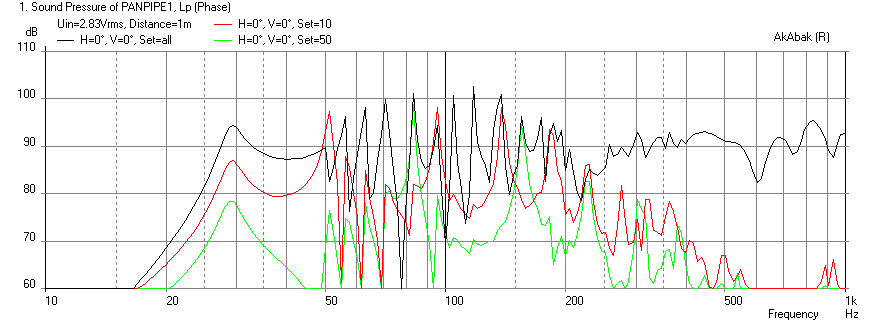I originally posted this idea in the DBLH thread here (http://www.diyaudio.com/forums/full-...ml#post3506867)which was for a Double Back Loaded Horn wall-mount speaker. This is clearly a different animal as it is not wall mounted and has many more pipes. Below is a repeat of original post to kick things off.
The speaker is sort of a conventional 'Scoop Bucket' type BLH in appearance. However, the cabinet is divided (top to bottom) into 5 separate horns, each tuned to a different frequency, and each fed by a common "throat" plenum connected to a driver chamber. The speaker is designed from scratch by individually optimizing the lengths, throats, mouths, and chamber volume to produce a relatively flat response that has deep bass extension, with each horn resonance peak offset from its neighboring horn resonance peaks.
Here is the simulation using AkAbak of a 5 horn BLH with the horns front facing and stacked next to each other at the bottom of the cabinet. I have not worked out the full physical dimensions of the cabinet and what it would take to fold and route the passages yet. I am assuming the cabinet will be 25 in wide to accommodate qnty 5 x 5 in wide horns. The longest horn is 144 inches and each successive one is multiplied by 0.9, 0.8, 0.7, and 0.6 factors. Horns mouth 1 (longest) will be 12 in tall x 5 in wide, the rest are all 8 in high x 5 in wide. The throats for each horn were optimized and ended up as 2 in, 0.7 in, 0.7 in, 1.0 in, 0.7 in (times width of channel of 5 in). A common throat leading from driver chamber to plenum manifold of multiple throats is 4.0 in to 5.0 in x 5.0 in long (times width of channel of 5 in). The driver chamber is 18 liters. The driver is the W5-1611, and all calcs were for 1 watt input measured at 1 meter away. The first plot shows the horn output for 1, 2, and 3. The second plot is for horn output 3, 4, and 5. The third plot shows the total output of all horns combined with driver direct radiation (black, red is longest horn, green is shortest horn). As you can see, there are lots of resonance peaks for each horn but the spacing is evenly spread out as expected and the amplitudes are pretty well balanced. I imagine that with damping added to the driver chamber, and maybe a little in the common plenum section these peaks will all be blended into one smooth output. The fourth plot is the impedance, fifth plot is the driver cone displacement, and sixth is impulse response.
Any feedback on this design from folks would be appreciated. Is this just too much trouble to get a smooth horn output? I think the advantage will be that the sound from this speaker will have all the benefits of immediacy in deep bass response (the impulse response is relatively quick compared to a bass reflex or MLTL that will have significant delay). So the sound should be more natural. The 30 Hz bass extension is quite impressive with controlled cone motion just at the limit of the driver's range.
This is response from horns 1(longest) to 3:
![Click the image to open in full size.]()
This is response from horns 3 to 5 (shortest):
![Click the image to open in full size.]()
This is the combined response including driver direct radiation (black) and longest (red) and shortest (green) horns:
![Click the image to open in full size.]()
This is the impedance:
![Click the image to open in full size.]()
This is the driver cone displacement:
![Click the image to open in full size.]()
And if you are interested in building this and don't want to yet spend $50 in a TB W5-1611 driver, very good results can also be obtained with a budget Monacor SP50X driver ($20 at MCM http://www.mcmelectronics.com/produc...P-50X-/55-4636) as shown below (thanks to @Ryani for pointing me in this direction). I will provide detailed build plans shortly. Foam core seems to be the way to go for test build and if you like it - go with wood.
Let me know if you are interested in a build and I will try to draw up plans soon.
Here is the freq response with the SP50X (no changes to cabinet):
![Click the image to open in full size.]()
The speaker is sort of a conventional 'Scoop Bucket' type BLH in appearance. However, the cabinet is divided (top to bottom) into 5 separate horns, each tuned to a different frequency, and each fed by a common "throat" plenum connected to a driver chamber. The speaker is designed from scratch by individually optimizing the lengths, throats, mouths, and chamber volume to produce a relatively flat response that has deep bass extension, with each horn resonance peak offset from its neighboring horn resonance peaks.
Here is the simulation using AkAbak of a 5 horn BLH with the horns front facing and stacked next to each other at the bottom of the cabinet. I have not worked out the full physical dimensions of the cabinet and what it would take to fold and route the passages yet. I am assuming the cabinet will be 25 in wide to accommodate qnty 5 x 5 in wide horns. The longest horn is 144 inches and each successive one is multiplied by 0.9, 0.8, 0.7, and 0.6 factors. Horns mouth 1 (longest) will be 12 in tall x 5 in wide, the rest are all 8 in high x 5 in wide. The throats for each horn were optimized and ended up as 2 in, 0.7 in, 0.7 in, 1.0 in, 0.7 in (times width of channel of 5 in). A common throat leading from driver chamber to plenum manifold of multiple throats is 4.0 in to 5.0 in x 5.0 in long (times width of channel of 5 in). The driver chamber is 18 liters. The driver is the W5-1611, and all calcs were for 1 watt input measured at 1 meter away. The first plot shows the horn output for 1, 2, and 3. The second plot is for horn output 3, 4, and 5. The third plot shows the total output of all horns combined with driver direct radiation (black, red is longest horn, green is shortest horn). As you can see, there are lots of resonance peaks for each horn but the spacing is evenly spread out as expected and the amplitudes are pretty well balanced. I imagine that with damping added to the driver chamber, and maybe a little in the common plenum section these peaks will all be blended into one smooth output. The fourth plot is the impedance, fifth plot is the driver cone displacement, and sixth is impulse response.
Any feedback on this design from folks would be appreciated. Is this just too much trouble to get a smooth horn output? I think the advantage will be that the sound from this speaker will have all the benefits of immediacy in deep bass response (the impulse response is relatively quick compared to a bass reflex or MLTL that will have significant delay). So the sound should be more natural. The 30 Hz bass extension is quite impressive with controlled cone motion just at the limit of the driver's range.
This is response from horns 1(longest) to 3:
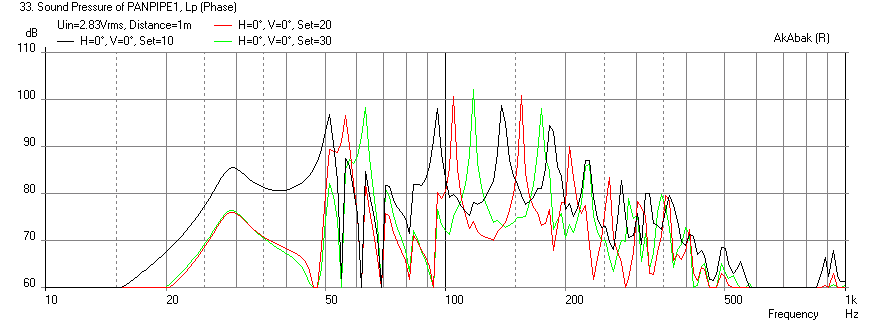
This is response from horns 3 to 5 (shortest):
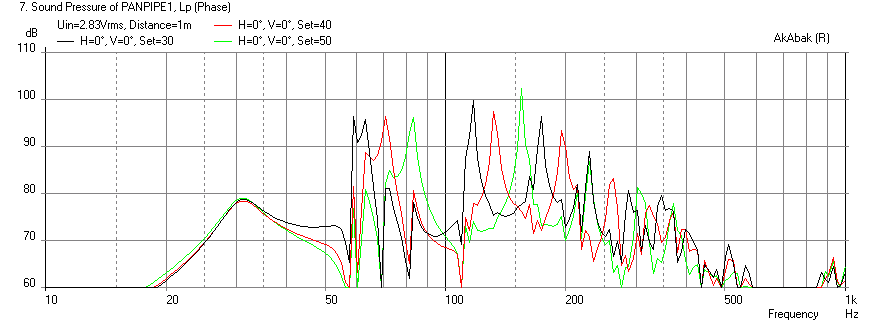
This is the combined response including driver direct radiation (black) and longest (red) and shortest (green) horns:
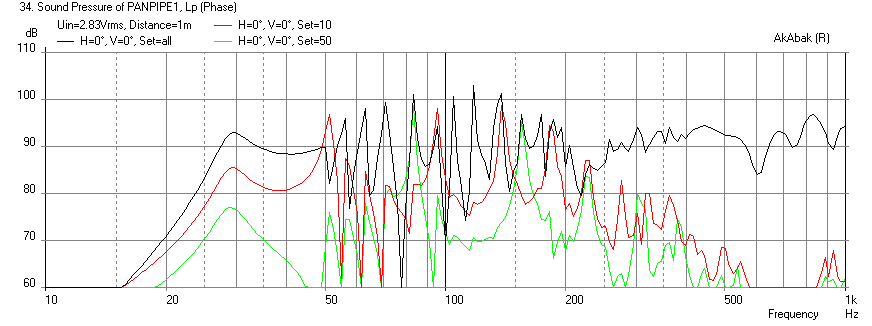
This is the impedance:
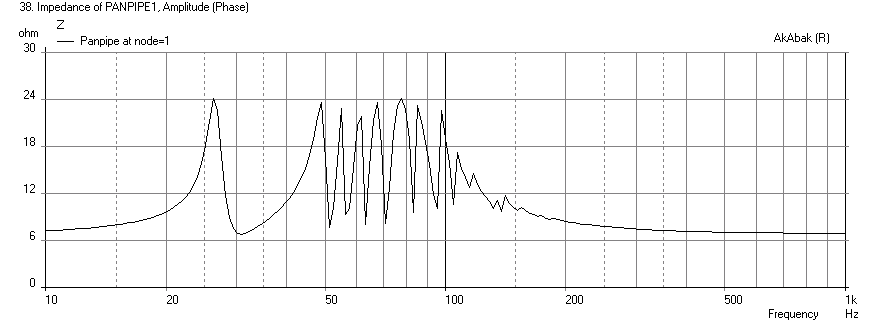
This is the driver cone displacement:
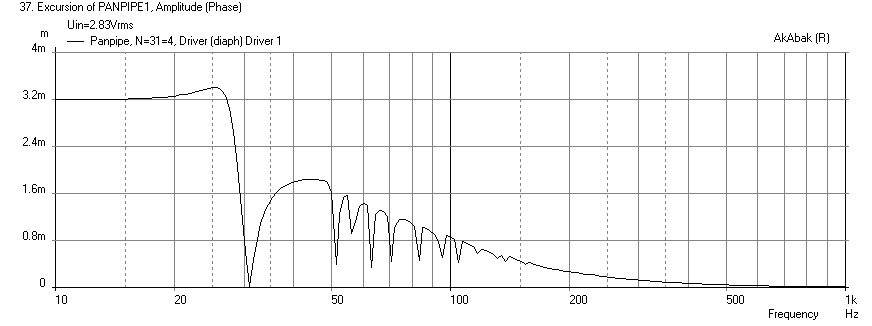
And if you are interested in building this and don't want to yet spend $50 in a TB W5-1611 driver, very good results can also be obtained with a budget Monacor SP50X driver ($20 at MCM http://www.mcmelectronics.com/produc...P-50X-/55-4636) as shown below (thanks to @Ryani for pointing me in this direction). I will provide detailed build plans shortly. Foam core seems to be the way to go for test build and if you like it - go with wood.
Let me know if you are interested in a build and I will try to draw up plans soon.
Here is the freq response with the SP50X (no changes to cabinet):
